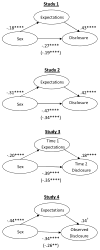How girls and boys expect disclosure about problems will make them feel: implications for friendships
- PMID: 22364264
- PMCID: PMC3342457
- DOI: 10.1111/j.1467-8624.2012.01734.x
How girls and boys expect disclosure about problems will make them feel: implications for friendships
Abstract
Although girls disclose to friends about problems more than boys, little is known about processes underlying this sex difference. Four studies (Ns = 526, 567, 769, 154) tested whether middle childhood to mid-adolescent girls and boys (ranging from 8 to 17 years old) differ in how they expect that talking about problems would make them feel. Girls endorsed positive expectations (e.g., expecting to feel cared for, understood) more strongly than boys. Despite common perceptions, boys did not endorse negative expectations such as feeling embarrassed or worried about being made fun of more than girls. Instead, boys were more likely than girls to expect to feel "weird" and like they were wasting time. Sex differences in outcome expectations did help to account for girls' greater disclosure to friends.
© 2012 The Authors. Child Development © 2012 Society for Research in Child Development, Inc.
Figures

References
-
- Aboud FE, Mendelson MJ. Determinants of friendship selection and quality: Developmental perspectives. In: Bukowski WM, Newcomb AF, Hartup WW, editors. The company they keep: Friendship in childhood and adolescence. New York: Cambridge University Press; 1996. pp. 87–112.
-
- Adams S, Kuebli J, Boyle PA, Fivush R. Gender differences in parent-child conversations about past emotions: A longitudinal investigation. Sex Roles. 1995;33:309–323.
-
- Baron RM, Kenny DA. The moderator-mediator variable distinction in social psychological research: Conceptual, strategic, and statistical consideration. Journal of Personality and Social Psychology. 1986;51:1173–1182. - PubMed
-
- Best R. We’ve all got scars. Bloomington: Indiana University Press; 1983.
-
- Buhrmester D, Furman W. The development of companionship and intimacy. Child Development. 1987;58:1101–1113. - PubMed
Publication types
MeSH terms
Grants and funding
LinkOut - more resources
Full Text Sources
Miscellaneous

